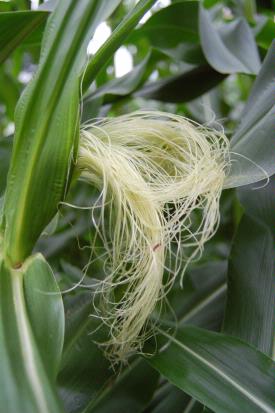In a recent blog post (https://valleyadvocate.com/blogs/home.cfm?uid=96) I wrote about some of the ferocious worms who compete with me for my corn. I can’t really blame them. All of that biomass must be irresistible. My plants are well over 7 feet tall now and if I could digest cellulose, I’d be all over them.
Of all the bugs on the corn, the most voracious are the various corn borers. Some dig into ears and some into the stems. The ear borers don’t kill the plant but give a nasty surprise when you peel back the husk only to find a tumescent squirming semi-translucent monster.

One of the more effective preventative measures is a toxin derived from Bacillus thuringiensis a soil bacterium that causes disease in caterpillars: Schlaffsucht. (Germans sure have a talent when it comes to naming things.) I’m impressed that in the early 1900’s a fellow pointy headed geek spent time figuring out what was making pantry moths caterpillars sick. When I’ve gotten moths in the pantry, I want them to get sick.
The bacterium makes a protein crystal. The crystal (cry protein) is insoluble and just hangs out until a caterpillar eats it. The caterpillar’s digestive system has a very high pH (like bleach). This and a digestive enzyme causes the cry protein to break into pieces that pierce the gut. Pierced gut = tummy ache for the caterpillar.
Caterpillar eating your corn? Rupture their guts!
And that’s exactly what I intend to do. One can purchase these bacteria, or even the purified protein and spray it on your plants. Is it organic? Well, I guess. It’s a biological control in a pretty clear sense. They’re also pretty specific to caterpillars (though any moth or butterfly larva will be affected). But it’s pretty damned toxic to the caterpillars.
Of course this mechanism tempted gene jockeys to insert the gene for the protein into agronomic crops. Now that pissed people off. Unless you’re really careful, you probably eat corn products that come from plants that made this protein. Your gut isn’t much like a caterpillar’s, so you won’t get a tummy ache. You might still be pissed off though.
For me, I just wallow in the irony that one of the great organic pesticides is also one of the most common GMOs.
Lots of good sources:
http://www.ext.colostate.edu/pubs/insect/05556.html/
http://www.bt.ucsd.edu/what_is_bt.html
http://www.extension.umn.edu/distribution/cropsystems/dc7055.html
http://web.expasy.org/spotlight/snapshots/014/


